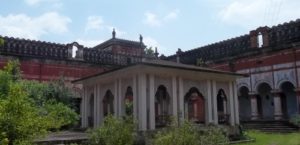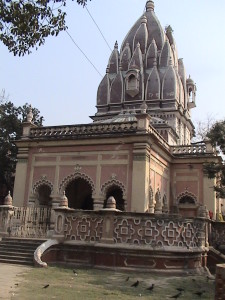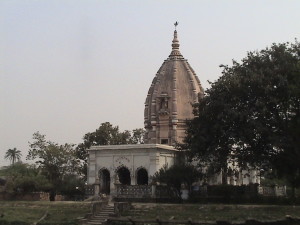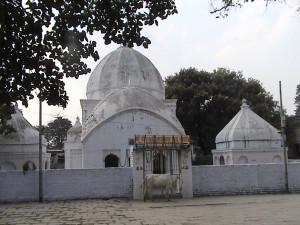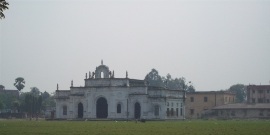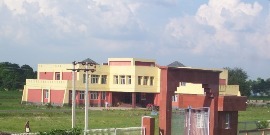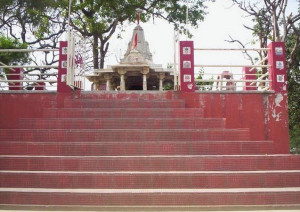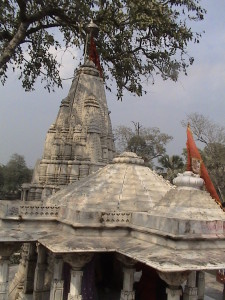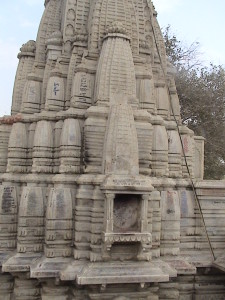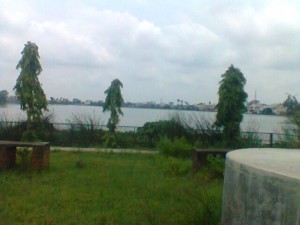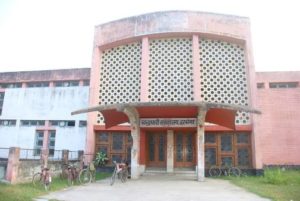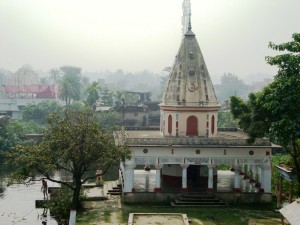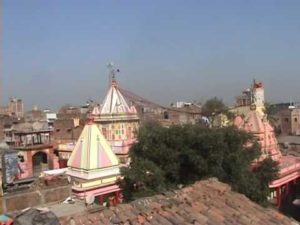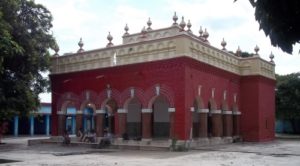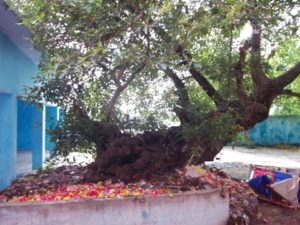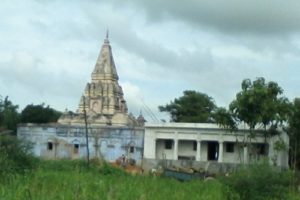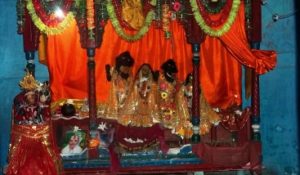Darbhanga gets its name from Dar Bhanga or “gates broken” (for gates of Hindu Qilā broken at Qilā Ghāt in 1326 AD when Tughlaq forces captured the last Hindu state in North India, ruled by Hari Singh Deva). Some people guess that Darbhangā is a distorted form of “Dwar Banga” or Dar-e-Bang meaning “THE GATEWAY TO BENGAL”. It is also said that the name of the district has been derived from its headquarter and principal town, which is said to have been founded by Darbhangi Khan. Under the British rule, Darbhanga was a part of 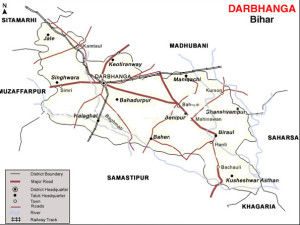
Sarkar Tirhut up to 1875, when it was constituted into a separate district. Then district Darbhanga has three sub-divisions as Darbhanga Sadar in 1845, Madhubani in 1846 and Samastipur in 1867. Darbhanga was part of Patna Division till 1908, when the separate Tirhut Division was carved out. Darbhanga became the Divisional headquarters in 1972 when all its three sub-divisions got the status of separate districts. Thus the present Darbhanga district took shape.The town is noted for its trade in fish, mango and makhana. Darbhanga city is essentially a twin city with Darbhanga tower and Laheriasarai tower at its two ends. Laheriasarai has been named after the famous Lahri walas whose traditional occupation was to weave textiles and make bangles especially of Lah, imported from Ranchi and other places.
How To Reach
By Airport :–
Darbhanga Airport is the longest runway airport of Bihar,and is operated by the Indian Air Force at present. It is spread over a 200-acre area of the city.
It was built exclusively for the use of Maharaja Of Darbhanga’s aeroplanes. Darbhanga Aviations was a private Indian airline started in 1950 by Maharaja Kameshwar Singh of Darbhanga. It had three aircraft and became defunct by 1962.
Spirit Air started operations from Darbhanga in 2009, but was forced to withdraw due to its smaller strip.
Spirit Airways started their flight from Darbhanga to major cities of India on 15 June 2015 with Bengaluru-based firm DTDS. As of now weekly flight services directly to and fro to the capital is available after so many herculean endeavors.
The other nearest airport, Lok Nayak Jayaprakash Narayan International Airport,Patna, is 129 kilometers.
By Rail :-
Darbhanga is strategically located on the East Central Railway (ECR) headquartered at Hajipur, with Railway Station as Darbhanga Jn (Main City Station), Laheria Sarai (Near Civil Court), Kakarghati, Bijuli halt, Tarsarai (Muria), Thalwara, Siso Halt, Mohammadpur, Kamtaul, Tektar, Hayaghat, Rambhadra Pur, Jogiara, Muraitha, Mandan Mishra Halt, Biroul, Mirzapur, Manigachi, Deora Bandhouli. Benipur Jn (Antour – Balha Stn.), Pohaddi Laxmipur Halt, Neuri Stn., Biraul Stn., Kusheshwar Sthan Stn.
There are three important railway lines:
• Darbhanga to Samastipur (Broad Gauge)
• Darbhanga to Sitamarhi (Broad Gauge)
• Darbhanga to Jaynagar (Broad gauge)
• Sakri to Biraul /Hasanpur/Khagaria – New BG line up to Biraul has been constructed.
• Sakri-Nirmali/Laukaha Bazar MG.
By Road :-
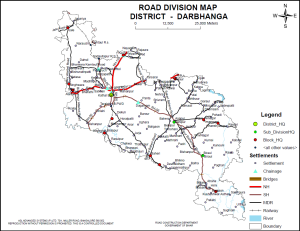 Well connected to other city through National Highway – 57(East West Corridor),105 SH-50,56,75 Other road-Jalley Atarbel Road,Bahera Baheri Road,Sakari Bahera Road,Bharwara Kamtaul Road,Bishanpur Attarbel Road,Tarsarai Raiyam,Benipur Bishanpur Road,Tarsarai Raiyam,Benipur Bishanpur Road,Keoti Raiyam Road,Jale Aurai Road.
Well connected to other city through National Highway – 57(East West Corridor),105 SH-50,56,75 Other road-Jalley Atarbel Road,Bahera Baheri Road,Sakari Bahera Road,Bharwara Kamtaul Road,Bishanpur Attarbel Road,Tarsarai Raiyam,Benipur Bishanpur Road,Tarsarai Raiyam,Benipur Bishanpur Road,Keoti Raiyam Road,Jale Aurai Road.
The city has two bus stands – Darbhanga Bus Stand and Laheriasarai Bus Stand. Bus services are available from Darbhanga to all the nearby major cities.
Darbhanga is located 125 kilometers from the state capital Patna.
Popular tourist destinations
INSCRIPTION
Epitaphs :- Belonging to the scions of the Mughal faimly of Delhi settled at Darbhanga , the deceased mentioned in the three epitaphs are : Nawwab Rif’at Sultanu’z Zamani Begum daughter of Mirza Muhammad Bokht, a descendant of Azizu’d- Din Alamgir II. She died in AH 1304 (AD1887) at the age of 14 years and 6 days. Nawwab’Azimu’n- Nisa Banu Begam daughter of Mirza Muhammad Azimu’d- Dir Bahadur who was the descendent of Muhommad Shah Alam II, She died in AH1314 (AD1896) at the age of 58 years and Mirza Hamid Sultan a descendant of Shah Alam II. He died in AH 1320 (AD1902)(ASI 83-84).
Popular tourist destinations
DARBHANGA BLOCK
Quila of Darbhanga Maharaj :- Palaces are the most important attractions in Darbhanga.Just a kilometre from the bus and train terminals,most of the palaces are located inside a walled campus.
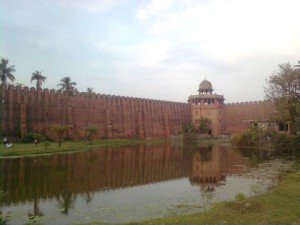 The today Darbhanga fort was a village namely Islampur and green belt of Nawab Aliwardi Khan of Murshimabad state of that time. The Nawab given this land to Maharajadhiraj Kameshwar Singh’s Ancestors. When Mahrajdhiraj Kameshwar singh came in power he decided to build a fort similar to another forts of India in year 1930. Maharajdhiraj Kameshwar Singh Compensated the peoples of Islampur village (the village was of Muslim Majority) and shifted them to Shivdhara, Alinagar, Laheriasarai-Chakdohra etc. outside the city.
The today Darbhanga fort was a village namely Islampur and green belt of Nawab Aliwardi Khan of Murshimabad state of that time. The Nawab given this land to Maharajadhiraj Kameshwar Singh’s Ancestors. When Mahrajdhiraj Kameshwar singh came in power he decided to build a fort similar to another forts of India in year 1930. Maharajdhiraj Kameshwar Singh Compensated the peoples of Islampur village (the village was of Muslim Majority) and shifted them to Shivdhara, Alinagar, Laheriasarai-Chakdohra etc. outside the city.
The Fort is bult up with red bricks spreaded over nearly 1 km long and 500 mtrs wide. There are two palaces inside the fort. in earthquack of 1970 major parts of western wall was distructed and one of the palace inside the fort was also partialy damaged. The fort is named after one of its palace Rambagh Palace. in which the place of worship to “Kul Devta” god of family is situated. this place of worship is not open for tourists. Rambagh Palace is still owned by members of Raj Darbhanga family. It is presently in a dilapidated condition. A modern hotel has now come up on the fort premises.
According to Jayaswal Research Institute Archaeological Explorations Rambagh Palace belongs to Medieval period.
Hari mandir and Gosaun Ghar (House of Kul Devta(Lord of Family):-
Laxmeshwar Vilas Palace( Anandbag Palace ):-
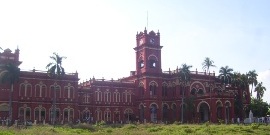 It is Constructed in the year 1880s. This palace was severely damaged in 1934 earthquake. It was rebuilt. The interiors of its elegant durbar hall is modelled on the interiors of Louis XVI’s Palace in Versailles.
It is Constructed in the year 1880s. This palace was severely damaged in 1934 earthquake. It was rebuilt. The interiors of its elegant durbar hall is modelled on the interiors of Louis XVI’s Palace in Versailles.
This palace was donated to Kameshwar Singh Sanskrit University. The durbar hall is now the Senate hall of Sanskrit University.
Nargauna Palace:-
 It is the residential quarters of the last Maharaja, was constructed after the earthquake of 1934. The building was built using the best technology for prevention of damages resulting from earthquakes. It was donated to Government of Bihar by Maharaja Kameshwar Singh for starting a University Currently, this palace is the head office of L.N.Mishra University.
It is the residential quarters of the last Maharaja, was constructed after the earthquake of 1934. The building was built using the best technology for prevention of damages resulting from earthquakes. It was donated to Government of Bihar by Maharaja Kameshwar Singh for starting a University Currently, this palace is the head office of L.N.Mishra University.
Bela Palace :-
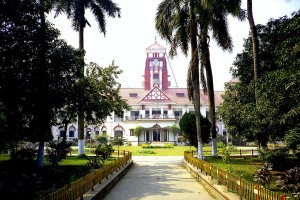 Built for Raja Bisheshwar Singh (Raja Bahadur), younger brother of Maharaja Kameshwar Singh, it is the best preserved palace. The palace was residence of Rajabahadur Bisheshwar Singh the younger brother of Maharajadhiraj Kameshwar Singh. The building has its own campus called Bela Garden. The campus has a pond and this was the house of crocodiles and aligators which ware pets of Rajabahadur.
Built for Raja Bisheshwar Singh (Raja Bahadur), younger brother of Maharaja Kameshwar Singh, it is the best preserved palace. The palace was residence of Rajabahadur Bisheshwar Singh the younger brother of Maharajadhiraj Kameshwar Singh. The building has its own campus called Bela Garden. The campus has a pond and this was the house of crocodiles and aligators which ware pets of Rajabahadur.
Legendary Kundan Lal Sehgal was a friend of Raja Bahadur .Whenever the two met, the Bela Palace witnessed long sessions of conversations and renditions of ghazals and thumris. Sehgal even attended the marriage of Raja Bahadur Sehgal took out his harmonium on impulse and sang “Babul mora naihar chhooto hi jaaye…”. Now it was taken over by the Government of India and a Postal Training College is situated in the palace.
Dilkhush Bag :- It is situated inside the Darbhanga Fort. It is almost in ruins.
Moti Mahal :- It was destroyed in the earthquake of 1934. It was not rebuilt. Only one room of Moti Mahal exists today.
The European Guest House :- A palatial structure on the Raj campus, it now houses the Makhana Research Institute. Mahatma Gandhi stayed here during his visits to Darbhanga.
Shri Rameshwari Shyama Temple (University Campus):-
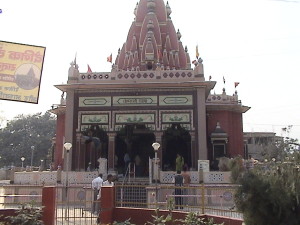 It is situated in the premises of Lalit Narayan Mithila University which is just one KM west of Darbhanga Railway Station.It was built in 1933.It is one of the most prominent temples built upon the private graveyard of the Darbhanga royal family and on the cremate of Late Maharajadhiraj Rameshwar Singh.
It is situated in the premises of Lalit Narayan Mithila University which is just one KM west of Darbhanga Railway Station.It was built in 1933.It is one of the most prominent temples built upon the private graveyard of the Darbhanga royal family and on the cremate of Late Maharajadhiraj Rameshwar Singh.
A huge statue of Goddess Kali is enshrined in this temple. This temple is famous for the faith that people here get there in desire fulfilled if they worship with holy heart.
According to Jayaswal Research Institute Archaeological Explorations this site belongs to Medieval period.
Shree Lakchhmiheswari temple:-
Shree Rudraheswari kali temple (Goddesss Kali):-
Small Mahadev mandir:-
Madheshwar Mahadev Mandir:- The only temple of the complex which is not on the cremate. The temple is of God Shiva (Mahadev) and as old as rameshwari shyama temple. It is situated just at the entry to the cremation ground.
Shri Kameshwari Shyama Temple:- This temple is on the cremation of last Maharajadhiraj Kameshwar Singh situated on the west-south corner of the pond of the complex.
Durga Panchaytan Temple (Goddesss Durga):-
Annpurna Temple (Goddesss Annpurna):-
Durga Panchaytan Temple (Goddesss Durga):-
An underconstruction Temple on the cremate of Rajmaata:–
Bell House:- It also look like a temple but it is just a bell house having a huge brash bell.
Indra Bhawan:-
Indra Bhawan is housed inside this university campus and is a historical remains of Raj Darbhanga
Mithila Research Institute :-
Mithila Research Institute has a great collection of nearly 50000 old manuscripts.
Makhana Research Institute :-
Kankali temple :-
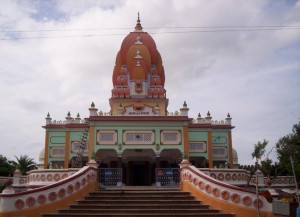 It is 2 km north west of Darbhanga Railway station in the premises of Qila of Darbhanga Maharaj. This temple is of utmost importance for Shakti people.
It is 2 km north west of Darbhanga Railway station in the premises of Qila of Darbhanga Maharaj. This temple is of utmost importance for Shakti people.
Laxmeshwari Tara Mandir :-
It is situated in the University Campus just beside Nargona Palace. This temple has constructed with the Marvel. In fact it is a Hanuman temple where a little but most beautiful statue of Hanuman is build of marvel. Raj Darbhanga had its own symphony orchestra and police band. There was a circular structure in front of Manakamana Temple, which was known as Band Stand. The band used to play music there in the evening. Today only the floor of band stand exists.
Malechchhed Mardini temple :–
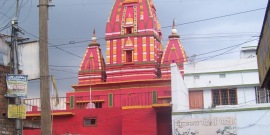 It is one km south west of Darbhanga Railway station. It is temple of the Goddess who destroy the faints. This temple is of utmost importance for Shakti people.
It is one km south west of Darbhanga Railway station. It is temple of the Goddess who destroy the faints. This temple is of utmost importance for Shakti people.
Nag Mandir ( Mishratola, Darbhang;-
Maharaja Laxmiswar Singh Museum :- It was established on 16th September 1977. It is situated just west south of Darbhanga Railway Station on the eastern bank of Mansarovar Lake. Prince Subheshwar Singh gifted the invaluable and immemorial items and Durlabh Kalakriti in order to establish this museum. Here is rare collection of a number of objects and weapons made of Gold, Silver, Tusker teeth all collection has been scientifically organized and placed into eight different chambers.
Hall Number 1: This hall is known as Raj Singhasan Kash. Royal throne of Maharaj Rameshwar singh jee has been placd in this Hall. It is made of gold, silver and precious stones. Besides royal throne, silver made Palang(BED), Nalki and a number of other such items has also been placed in this hall which are pleasant memory of yester years of royal family. Royal throne and Silver Bed are unique examples of Sculptural excellence.
Hall Number 2: Hall of Metallic artifacts: A number of attractive artifacts have shown in this hall and among these unique globe made of copper and circular shield are can be of attraction. In these two artifacts important events of Ramayana, Mahabharata and Krishna-Leela has been reflected.
Hall Number 3: Hall of stone idols and artifacts:
Statue made of marble and other stone made artifacts have been shown in his hall. A circular table made of a single piece of marble is treat to watch. A number of women have been inscribed one it in Greek – style. The clothes hair and physique of there women reflects the clear impact of greekan style. Just like greekan style the clothes are transparent and its fold are such that it seems it has been blown up by air. The curly hair looks very natural.
Hall Number 4 & 5: Ivory Hall. There is a unique collection of the artifacts made of ivory. Mat, Net, flowers, leaves and a lot of other things, made of ivory, are just superb in its presentation. A spulse made of ivory is so lively that visitors get mazes after seeing it. Beside this Ivory mad lions and sofa-set also attract the visitors very much.
Hall Number 6: Hall of weapons. Weapons of the various kings have been shown in this hall.
Hall Number 7 & 8: Hall of wooden artifacts. These two halls painting wooden artifacts have been shown in so natural that it works like metal.
Museum can be visited every day except Monday. Its opening and closing time is 10.00 AM and 4.30 PM respectively.
Haraahi pond :-
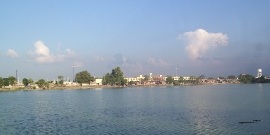 Shree Hari Singh Deo, King of the Karnataka Chalukya dynasty from Karnataka, who ruled over North Bihar and most of Nepal. He was the Last independent North Indian Hindu king. Historians guess that the capital of Harisingh Deva was situated near foothills of Himalayas. Haraahi pond in Darbhanga is named after Harisinghdeva and the pond Gangaasagar is named after his ancestor Gangadeva who was son of Naanyadeva, the founder of this dynasty. Naanyadeva was a chieftain of Chalukya king Vikramaditya-VI of Karnataka who had successfully invaded North India in the end of 11th century.
Shree Hari Singh Deo, King of the Karnataka Chalukya dynasty from Karnataka, who ruled over North Bihar and most of Nepal. He was the Last independent North Indian Hindu king. Historians guess that the capital of Harisingh Deva was situated near foothills of Himalayas. Haraahi pond in Darbhanga is named after Harisinghdeva and the pond Gangaasagar is named after his ancestor Gangadeva who was son of Naanyadeva, the founder of this dynasty. Naanyadeva was a chieftain of Chalukya king Vikramaditya-VI of Karnataka who had successfully invaded North India in the end of 11th century.
According to one local tradition the tanks were excavated by the Muslims rulers to secure a raised ground for soldiers’ quarters while another local legend attributes the excavations to the famous Raja Seva Singh of Mithila who flourished at the end of the 14th century A. D.
This is a one of the popular pond among 3 pond in Darbhanga City near by Railway Station.
Dighi (Tank) Pokhar:-
According to one local tradition the tanks were excavated by the Muslims rulers to secure a raised ground for soldiers’ quarters while another local legend attributes the excavations to the famous Raja Seva Singh of Mithila who flourished at the end of the 14th century A. D.
According to Jayaswal Research Institute Archaeological Explorations this site belongs to Early medieval period.
Gangaasagar pond :- Pond Gangaasagar is named after Harisinghdeva ancestor Gangadeva who was son of Naanyadeva, the founder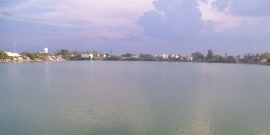 of Karnataka Chalukya dynasty. Naanyadeva was a chieftain of Chalukya king Vikramaditya-VI of Karnataka who had successfully invaded North India in the end of 11th century.
of Karnataka Chalukya dynasty. Naanyadeva was a chieftain of Chalukya king Vikramaditya-VI of Karnataka who had successfully invaded North India in the end of 11th century.
According to one local tradition the tanks were excavated by the Muslims rulers to secure a raised ground for soldiers’ quarters while another local legend attributes the excavations to the famous Raja Seva Singh of Mithila who flourished at the end of the 14th century A. D.
Hanumeshwar Nath Mandir (Gangaasagar pond):-
Saraswati Mandir (Gangasagar, Darbhanga):-
Lakhi Bagh :- Akbar also planted 100,000 mango trees in Darbhanga, at a place now known as Lakhi Bagh.
Catholic Church :-
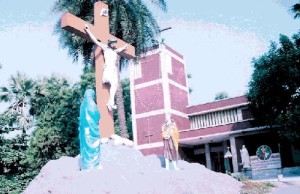 It is situated just one km form the Darbhanga Railway Station. It is established in 1891. It was an old bungalow type church where training was given to Christine fellow.Though the original building was damaged by the earthquake of 1897, later on it was reconstructed.The church is also known by the name Holy Rosary Church. There is also Anand Mela on 7th October every year which is open to participation by public.
It is situated just one km form the Darbhanga Railway Station. It is established in 1891. It was an old bungalow type church where training was given to Christine fellow.Though the original building was damaged by the earthquake of 1897, later on it was reconstructed.The church is also known by the name Holy Rosary Church. There is also Anand Mela on 7th October every year which is open to participation by public.
Bhikha Salami Majar :- It is situated at one km southeast from Darbhanga Railway station on the bank of Gangasagar pond. A fair is to be organized between 12th and 16th day during the Ramzan.
Darbhanga Tower :-
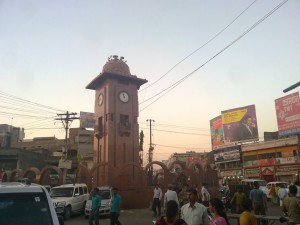 Darbhanga Tower is situated at two km west from the Darbhanga Railway Station.
Darbhanga Tower is situated at two km west from the Darbhanga Railway Station.
Masjid at Darbhanga Tower :-
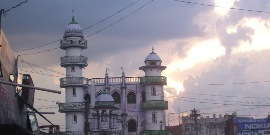 It is the most attractive and religious place for the Islam religion.
It is the most attractive and religious place for the Islam religion.
The Mazar of Makhdoom BabaI :-
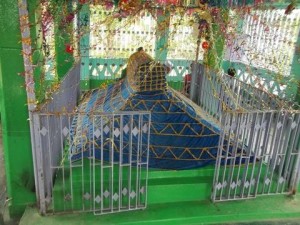 It is situated at 2 km northwest from Darbhanga Railway Station. It is the very popular secularism place. Here daily people from Islam religion as well as Hindu religion assemble for offering their prayers.
It is situated at 2 km northwest from Darbhanga Railway Station. It is the very popular secularism place. Here daily people from Islam religion as well as Hindu religion assemble for offering their prayers.
Khankah Samarkandia (Darbhanga):- Mausoleum of a Muslim saint, named Hazrat Maulana Samarkandi Rahmatullah Alaih is situated about one and half kilometers east of mohallah Mishra Tola and on the westerly south corner of a tank known as Sukhi Dighi, south of the Darbhanga railway station. It is said that the saint had demonstrated miracles on many occasions and had helped people overcome their problems. It is said that the saint hand established here a Khanqah about 132 years back. The annual Urs of the saint is held here in the month of July. Women are not allowed to participate in the Urs.
Khanquah Alla Samarqandia :-
SAHAB E SAJJADA: SYED MOHAMMAD SHAMSULLAH JAAN
SAHAB ALMAROOF BABU HUZOOR.
Darbar Mohajir E Makka(Bhatgaon Sharif):-
HAZRAT SYED SADULLAH DATA PIR KANGALI SHAH R.A
Khanquah Faiz E Nijeeb(Saraisattar Khan) :-
SAHAB E SAJJADA
FAIZ AHMAD QUADRI mada zilla hul aali.
Chandradhari Museum :- This museum was established on 7 December 1957 on the north bank of Mansarovar Lake. Late Chandradhari Singh of Ranti Dyordhi (Madhubani) donated all the artifact and other rare objects. It was shifted in double story building in 1974.On the basis of arrangement and materials of the Museum it can be divided into eleven type of gallery.Aims of the Museum, to collect, to preserve and to display the artifacts of historical, archaeological and cultural importance of the region in the public interest as well as to educate the students through the exhibited material Galleries.
Glass Gallery – In this gallery beautiful objects of Belgium cutting glass are displayed.
Textile Gallery – Traditional dress of Mithila as well as dress of Royal family have been shown in this Gallery.
Miniature Painting Gallery – In this gallery rare miniature paintings of different school, such as the Persian, Mughal,Rajasthan, Kangra etc. are displayed. Of the special interest are the sets of paintings illustrating the Ramayana, Gita, Gita-Govinda, Shah-nama.
Modern Painting – Water colour paintings of modern style based on Ramayan and Mahabharta theme such as “Raja Janak Darbar” and “Mahabharta War” can be seen here.
Stone Sculpture Gallery – Sculptures in black Basalt stone of Hindu and Buddha religion have been shown in this gallery. Most of the sculpture belongs to the 8th & 9th century A.D.
Wood Gallery –Various types of wood objects having floral design and inlay work are displayed in this gallery.Mother of Pearls Gallery, Royal Bengal Tiger, Leopard, Bear and different types of horns of deer have been displayed in this gallery.
Mother of Pearls Gallery – In this gallery several types of beautiful exhibit made art of mother of pearls can be seen. A replica of Taj Mahal, made of mother of perals on a single piece of tuch stone is an unique one.
Natural History Gallery – Various types of beautiful icons and objects of ivory are displayed in this gallery.
Ivory Gallery – Various types of beautiful icons and objects of ivory are displayed in this gallery.
Brass Gallery – Statues in brass, brought from Rajnagar of Madhubani District have been shown in this gallery. These statues are of Nepalese and Tibetan style.
Special Gallery – Ek mukhi Rudraksha Garlands of semi precious stones, Mico paintings, Ancient and Modern Coins Flowers pots of Zade stone, Ivory etc are beautifully arranged and displayed.
This museum has its own Strong Room.In this room ring of preceious stones, Gold coins, Pancha Janya Sankh, Dakshina Vartaya sonkh, Shree chakra etc are will preserved.
This museum has also its own small library, having different types of historical and cultural books along with same manuscripts. Virata-Parvan of the Mahabharata, written in the Mithilakshar of the fourteenth century, deserve special mention.
The exhibits being properly displayed with labels in English, Hindi and Maithili.
It remains open for public on everyday except Monday.
Khojpur :-This is the part of Laheriasarai town. A much disturbed structural mound of Pala Period was found By D.K.C.Khojpur Siva Temple (13th Century A.D.). It contains an inscription on a pedestal of the image of Durga which is worshiped by the villagers. It records installation of the image and is dated 147 in the Lakshmana Sena era, i.e. in 1253-54 A.D.
Sai Baba Mandir( Seeshow):- A Very beautiful Sri Shirdi Sai Baba Mandir has been constructed recently on the bank of holy river Sadaneera Bagmati in the village Seeshow (East) by divine blessings of Sai Baba. This mandir is located 9 k.m west from Darbhanga Railway station and 5 k.m west from Darbhanga main bus stand. This mandir has been constructed by the tremendous effort and support of Shri R.S.Kushwaha & family on the land donated by late Babu Shri Ram Kripal Kushwaha of village Seeshow Dih.The Mahabhishek pujan of Bhagwan Shri Sai Nath is performed every Thursday morning 6.30 AM.
Sati Asthan(Subhankarpur):-
I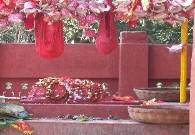 t is situated in the famous graveyard of Subhankarpur which is about one km west of Darbhanga Maharaj bridge. Maharaja Rameshwar Singh who was also a great Tantrik used to visit here daily in mid night for his Tantra Siddhi.
t is situated in the famous graveyard of Subhankarpur which is about one km west of Darbhanga Maharaj bridge. Maharaja Rameshwar Singh who was also a great Tantrik used to visit here daily in mid night for his Tantra Siddhi.
Lakshmi Sagar:– According to one local tradition the tanks were excavated by the Muslims rulers to secure a raised ground for soldiers’ quarters while another local legend attributes the excavations to the famous Raja Seva Singh of Mithila who flourished at the end of the 14th century A. D.
Mavi:- As per exploration done by KP Jayaswal Research Institute marked Period of site as Late medieval. Kameshwar Nagar:- As per exploration done by KP Jayaswal Research Institute marked Period of site as Medieval.
Laheriasarai:- As per exploration done by KP Jayaswal Research Institute marked Period of site as Medieval
Laheriasarai Tower:-
Ram Janki Mandir (Kabilpur):-
Sonaki:- As per exploration done by KP Jayaswal Research Institute marked Period of site as Early medieval. Manihas Dih:- As per exploration done by KP Jayaswal Research Institute marked Period of site as Early medieval. Dhoi Dih:- As per exploration done by KP Jayaswal Research Institute marked Period of site as NBPW phase. Kalyana Dih:- As per exploration done by KP Jayaswal Research Institute marked Period of site as Early medieval. Narkatiya Dih:- As per exploration done by KP Jayaswal Research Institute marked Period of site as Early medieval.
BENIPUR BLOCK
Nawadah Durga sthan( Majkora Nawadah Road):- It is famous temple of Goddess Durga Located on the Majkora Nawadah Road. Everyday hundreds of devotee’s visited this place . The Dussehra festival is celebrated here with great enthusiasm.
Shivram Dih:- As per exploration done by KP Jayaswal Research Institute marked Period of site as NBPW phase. Gharaura:- As per exploration done by KP Jayaswal Research Institute marked Period of site as Early medieval. Laxmipur Bayo:- As per exploration done by KP Jayaswal Research Institute marked Period of site as Early medieval. Sipaul Dih (Larsarma Dih):- As per exploration done by KP Jayaswal Research Institute marked Period of site as NBPW phase. Kanthu Dih:- As per exploration done by KP Jayaswal Research Institute marked Period of site as NBPW phase. Dharaura Dih:- As per exploration done by KP Jayaswal Research Institute marked Period of site as NBPW phase. Hari Bhauor Dih:- As per exploration done by KP Jayaswal Research Institute marked Period of site as NBPW phase. Rahiyam Dih:- As per exploration done by KP Jayaswal Research Institute marked Period of site as NBPW phase.
BAHERI BLOCK
Gujrauli:- As per exploration done by KP Jayaswal Research Institute marked Period of site as Early medieval. Machhi:- As per exploration done by KP Jayaswal Research Institute marked Period of site as NBPW phase. Jorja Dih:- As per exploration done by KP Jayaswal Research Institute marked Period of site as Early medieval. Baligaon:- As per exploration done by KP Jayaswal Research Institute marked Period of site as NBPW phase. Harinagar Dih:- As per exploration done by KP Jayaswal Research Institute marked Period of site as NBPW phase. Sunkheraha Dih:- As per exploration done by KP Jayaswal Research Institute marked Period of site as NBPW phase. Ramauli Dih:- As per exploration done by KP Jayaswal Research Institute marked Period of site as NBPW phase. Barmottar Dih:- As per exploration done by KP Jayaswal Research Institute marked Period of site as NBPW phase. Atahar Dih:- As per exploration done by KP Jayaswal Research Institute marked Period of site as Early medieval. Birchakka Chaur:- As per exploration done by KP Jayaswal Research Institute marked Period of site as Early medieval. Nimaithi:- As per exploration done by KP Jayaswal Research Institute marked Period of site as NBPW phase. Metuniya Dih:- As per exploration done by KP Jayaswal Research Institute marked Period of site as Early medieval. Murli (Soharana Dih):- As per exploration done by KP Jayaswal Research Institute marked Period of site as NBPW phase. Inai Dih:- As per exploration done by KP Jayaswal Research Institute marked Period of site as NBPW phase.
Mound (Brahmastha) (Naudega Dih):- The Sakari – Baheri road pass through the mound which seems to be a 3 acres structural mound and is locally known as Brahmasthan.
As per exploration done by KP Jayaswal Research Institute marked Period of site as NBPW phase period.
Saharan Dih:- :- The site is about 30.5 acres in extent. Now it is thickly planted over a large tree but shows remains about 1.5 m high above the level of the surrounding field. Dilip.K.C.found micaceous black and red ware and early historic pottery here.
Gangdah:- As per exploration done by KP Jayaswal Research Institute marked Period of site as Early medieval. Shivram Dih:- As per exploration done by KP Jayaswal Research Institute marked Period of site as NBPW phase. Kangara Dih (Benduli):- As per exploration done by KP Jayaswal Research Institute marked Period of site as Early medieval. Baheri:- As per exploration done by KP Jayaswal Research Institute marked Period of site as Early medieval. Sadhua Dih:- As per exploration done by KP Jayaswal Research Institute marked Period of site as Early medieval. Saguniya dih:- As per exploration done by KP Jayaswal Research Institute marked Period of site as NBPW phase. Badhauni Dih:- As per exploration done by KP Jayaswal Research Institute marked Period of site as NBPW phase. Murballa Dih:- As per exploration done by KP Jayaswal Research Institute marked Period of site as NBPW phase. Gobarahi Dih (Dihwar):- As per exploration done by KP Jayaswal Research Institute marked Period of site as Early medieval.
BAHADURPUR BLOCK
Lord Mahadeva Temple (Chhaprar):- The village is situated at a distance of about 10 Kms from District Headquarter. It has a temple of Lord Mahadeva on the bank of the Kamla River around which fairs are held on the occasion of Kartik and Maghi Purnima.
Deokuli Dih:- As per exploration done by KP Jayaswal Research Institute marked Period of site as Early medieval. Kali Dih (Khaira):- As per exploration done by KP Jayaswal Research Institute marked Period of site as Early medieval. Sakari Dih(Premjeebar):- As per exploration done by KP Jayaswal Research Institute marked Period of site as Early medieval. Pingi Dih:- As per exploration done by KP Jayaswal Research Institute marked Period of site as Early medieval. Mekana Dih:- As per exploration done by KP Jayaswal Research Institute marked Period of site as Early medieval. Baruara:- As per exploration done by KP Jayaswal Research Institute marked Period of site as Early medieval. Jalokhar:- As per exploration done by KP Jayaswal Research Institute marked Period of site as Early medieval. Gangiya:- As per exploration done by KP Jayaswal Research Institute marked Period of site as Early medieval. Sri Dilpur Dih:- As per exploration done by KP Jayaswal Research Institute marked Period of site as Early medieval. Taralahi:- As per exploration done by KP Jayaswal Research Institute marked Period of site as Early medieval. Bhagirath dih:- As per exploration done by KP Jayaswal Research Institute marked Period of site as Early medieval. Parauna Patti Dih:- As per exploration done by KP Jayaswal Research Institute marked Period of site as Early medieval. Baruara Dih Tol:- As per exploration done by KP Jayaswal Research Institute marked Period of site as Early medieval. Dharmpur Dih:- As per exploration done by KP Jayaswal Research Institute marked Period of site as Medieval. Shobham Dih:- As per exploration done by KP Jayaswal Research Institute marked Period of site as Early medieval. Shahpur Dih:- As per exploration done by KP Jayaswal Research Institute marked Period of site as Early medieval.
JALE BLOCK
Ahilya AsthanIt (Ahirari Hindu Temple):-
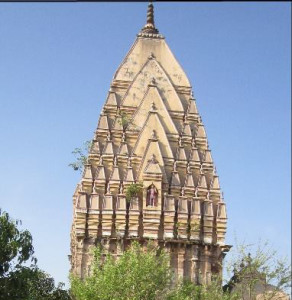 It is situated at Ahilya gram village. Which is about 24 kms north-west of Darbhanga and is about 3 Km South of Kamtaul Railway Station in Jale Block. It has a famous historical temple, dedicated to Ahalya, wife of Gautam Rishi.
It is situated at Ahilya gram village. Which is about 24 kms north-west of Darbhanga and is about 3 Km South of Kamtaul Railway Station in Jale Block. It has a famous historical temple, dedicated to Ahalya, wife of Gautam Rishi.
According to Ramayana when Lord Ram was his way to Janakpur his feet touched a stone and it turned into a woman who was non-else but Ahilya. Her husband Gautam Rishi cursed the Ahilya to fun into stone.Ramayana describes it as Ahalya-Uddhar. Large fairs are held every year on the occasion of Ramnavami in the Hindi month of Chaitra and Vivah Panchami in Agrahayan.
Maharaja Chatra Singh Bahadur of Darbhanga built the present temple in 1817
There are various other temples and mosques in the village.
As per exploration done by KP Jayaswal Research Institute marked Period of site as Late medieval period.
Gautam Kund(Brahmpur):- It is situated in the village Brahmpur which is about 8 km away from kamtaul railway station in Dharbhaga District.In regard to the Gautam Kund, it is believed that God Brahma himself created the tank by piercing the earth with seven arrows, so that Gautam might not have to travel a long distance for bathing in the Ganga.
An early historical site yielding grey, red and black wares was discovered in year74-75 by ASI exploration.
Temple of Gautam Rishi(Brahmpur):- It is in Brahmpur village. The village is situated about 8 kms. away from Kamtaul. According to the Puranic tradition Lord Brahma appeared before Gautam Rishi at this place after the chastity of his wife, Lord Indra and Chandrama had violated Ahalya. The village derives its name from this occurrence.
Kamtaul :- The village is a rail head in Jale block. The village has a Khadi Gamodyaog centre and a Khadi store.It is the rail head for visitors to Gautamsthan and Ahalyasthan .
Purnadih:- There is a large , high grass covered stupa mound at this place between kamtaul and kadamchhaur more.
Gangeshwar Asthan:- As per exploration done by KP Jayaswal Research Institute marked Period of site as Early medieval.
ALINAGAR BLOCK
Borawa:- As per exploration done by KP Jayaswal Research Institute marked Period of site as Medieval
KEOTI BLOCK
Bhuiya Asthan Dih (Madho Patti):- As per exploration done by KP Jayaswal Research Institute marked Period of site as Early medieval. Kahariya Dih:- As per exploration done by KP Jayaswal Research Institute marked Period of site as Early medieval. Wariaul:- As per exploration done by KP Jayaswal Research Institute marked Period of site as Late medieval
HAYAGHAT BLOCK
Horalpatti:- As per exploration done by KP Jayaswal Research Institute marked Period of site as Early medieval. Kelhuara Dih:- As per exploration done by KP Jayaswal Research Institute marked Period of site as Early medieval.
GHANSHYAMPUR BLOCK
Kherahan Dih (Korthu):- As per exploration done by KP Jayaswal Research Institute marked Period of site as Early medieval. Borwa Dih:- As per exploration done by KP Jayaswal Research Institute marked Period of site as Early medieval. Dah PokharL- As per exploration done by KP Jayaswal Research Institute marked Period of site as Early medieval. Bajrangbali Dih (Korthu East):- As per exploration done by KP Jayaswal Research Institute marked Period of site as Medieval. Bel Dih:- As per exploration done by KP Jayaswal Research Institute marked Period of site as Early medieval. Bari Itakoria Dih:– As per exploration done by KP Jayaswal Research Institute marked Period of site as Early medieval.
BIRAUL BLOCK
Dekulldham :-
The village falls in Biraul block and is noted for is large temple of Lord Shiva. A large annual fair is held on the occasion of Shivaratri.
Mahinam-Mahadeo-sthan :- It is temple of Lord Shiva situated at a distance of about 5 Km from the Darbhanga-Biraul pucca road. Large annual fairs are held here on the occasion of Kartik and Maghi Purnima
Raja Lorick Ancient fortress(Newri):- The village likes about 13 Kms. west of the block head quarters at Biraul and contains the remains of an ancient fortress associated with Raja Lorick.
Manorbhorma (Bhorma):- As per exploration done by KP Jayaswal Research Institute marked Period of site as NBPW phase. Korhali Dih:-As per exploration done by KP Jayaswal Research Institute marked Period of site as NBPW phase. Usari Dih:– As per exploration done by KP Jayaswal Research Institute marked Period of site as Early medieval. Sona Dih:- As per exploration done by KP Jayaswal Research Institute marked Period of site as Early NBPW.Harpur Kala Dih:- As per exploration done by KP Jayaswal Research Institute marked Period of site as NBPW phase. Belgaon Dih:- As per exploration done by KP Jayaswal Research Institute marked Period of site as NBPW. Shivpur Dih:- As per exploration done by KP Jayaswal Research Institute marked Period of site as Early medieval. Belhi Dih:- As per exploration done by KP Jayaswal Research Institute marked Period of site as Early medieval.
KUSHESHWAR ASTHAN BLOCK
Kusheshwar Asthan:-
It is an important religious place, situated about 16 Kms east of Singhia and 22 Kms northeast of Hasanpur Road railway station on the Samastipur – Khagaria Branch line of North Eastern Railway and approx 45 Kms East of Darbhanga Town.It is noted for the temple of Lord Shiva known as Kusheshwarasthan. The origin of this temple is traced to the epic period. Pilgrims visit this place all the year round for worship.
Kusheshwar Sthan Closed Area (Kusheshwarasthan Bird Sanctuary):- It is located about 45 km from the town of Darbhanga. It is establishrd in year 1972. Fourteen villages Darbhanga are in an area of over seven thousand acres, preserved as a wetland Kusheshwarasthan Bird Sanctuary , is formed of 6700 hects Chour Area, 1400 hects of Low land area. The vast water bodies spread in approx 8100 hects. during winter between November and March..
It is the winter capital of approximately 15 rare and endangered species of migratory birds. The winged guests coming from over eight countries,Nepal, Tibet, Bhutan, Afghanistan, China, Pakistan, Mongolia & Siberia and others,swarm during November and March.
Important migratory birds seen in Kusheshwar Asthan Bird Sanctuary are (Local Name) Lalshar, Dighouch, Mail, Nakta, Gairi, Gagan, Silli, Adhani, Harial, Chaha, Karan, Ratwa, Gaiber (White and Black),(Biological Names) Dalmatian pelican, Anlinga rufa (Indian darter) Barhead Goose, Cariva Scutulata, (White wing wood duck), Marmaronetta (Marbled teal), Baer’s Pochard, Sibrian Crain, Indian Skimmer, Oriental Goosander. ( Rarely Seen)
SINGHWARA BLOCK
Bharwara (Bharora):- It is about 6 km from Singhwara Block Headquater and 19 km far from its District Main City Darbhanga.It is the birth place of Shri Gonu Jha, a well known comedy and Pratyutpanmati Charactor of Mithila. It is said that Gonu Jha has been blessed by Goddess Kali to such an extent that she, herself was defeated in wits and humour by pandit Gonu Jha. Other story is that The Kamla river changed his course after defeated by Gonu Jha. Gonu Jha pihani (a collection of stories on Gonu Jha) is read even today in every household of Mithila. His story is very famous throughout the Mithila region, like that of Akbar and Birbal in north India or Tenaliram.
Rampur Dih:- As per exploration done by KP Jayaswal Research Institute marked Period of site as Early medieval. Bedauli Dih:- As per exploration done by KP Jayaswal Research Institute marked Period of site as Early medieval. Hanuman Nagar Dih:– As per exploration done by KP Jayaswal Research Institute marked Period of site as Early medieval. Bharati Dih:– As per exploration done by KP Jayaswal Research Institute marked Period of site as Early medieval. Singhwara:– As per exploration done by KP Jayaswal Research Institute marked Period of site as NBPW phase. Sanahpur Dih:- As per exploration done by KP Jayaswal Research Institute marked Period of site as Early medieval. Arai dih:–As per exploration done by KP Jayaswal Research Institute marked Period of site as Early medieval. Chamanpur Dih:– As per exploration done by KP Jayaswal Research Institute marked Period of site as NBPW phase. Simari Dih:– As per exploration done by KP Jayaswal Research Institute marked Period of site as Early medieval. Nunthara Dih (Gonu Jha Dih):–As per exploration done by KP Jayaswal Research Institute marked Period of site as Early medieval. Gaura Dih:-As per exploration done by KP Jayaswal Research Institute marked Period of site as Early medieval. Birdipur Dih Tol:- As per exploration done by KP Jayaswal Research Institute marked Period of site as Early medieval. Bajrahi Dih (Paira):-As per exploration done by KP Jayaswal Research Institute marked Period of site as Early medieval. Haritol Dih:- As per exploration done by KP Jayaswal Research Institute marked Period of site as Early medieval. Dahashil Dih:- As per exploration done by KP Jayaswal Research Institute marked Period of site as Early medieval. Karauni Dih:- As per exploration done by KP Jayaswal Research Institute marked Period of site as Early medieval. Bharwara dih:- As per exploration done by KP Jayaswal Research Institute marked Period of site as NBPW phase. Kauar Dih (Kora):- As per exploration done by KP Jayaswal Research Institute marked Period of site as NBPW phase. Takamia dih:– As per exploration done by KP Jayaswal Research Institute marked Period of site as Medieval. Sakaro Dih:- As per exploration done by KP Jayaswal Research Institute marked Period of site as Early medieval. Meha Dih (Kumar Patti):– As per exploration done by KP Jayaswal Research Institute marked Period of site as NBPW phase.
Dargaah(Nista Sharif near Sanapur):-
HAZRAT SYED DAATA NOORUL HALIM SHAH R.A,
HANUMAN NAGAR
Dhubauli Dih (Patori):– As per exploration done by KP Jayaswal Research Institute marked Period of site as Early medieval. Basuara Dih:– As per exploration done by KP Jayaswal Research Institute marked Period of site as Early medieval. Kali Dih:- As per exploration done by KP Jayaswal Research Institute marked Period of site as Early medieval. Gorhari Dih:- As per exploration done by KP Jayaswal Research Institute marked Period of site as NBPW phase. Gaudaila Dih:– As per exploration done by KP Jayaswal Research Institute marked Period of site as Early medieval. Amma Dih:– As per exploration done by KP Jayaswal Research Institute marked Period of site as Early medieval. Narsara Dih:– As per exploration done by KP Jayaswal Research Institute marked Period of site as Early medieval. DihLohi:- As per exploration done by KP Jayaswal Research Institute marked Period of site as NBPW phase. Sinhasani Dih:- As per exploration done by KP Jayaswal Research Institute marked Period of site as Early medieval. Chatrapura Ghat Dih:– As per exploration done by KP Jayaswal Research Institute marked Period of site as Early medieval. Dhamma Veer Dih (Dumrama):- As per exploration done by KP Jayaswal Research Institute marked Period of site as Early medieval.
Bangali Dih (Panchobh):–As per exploration done by KP Jayaswal Research Institute marked Period of site as NBPW phase.
Panchobh Ancient Site and an inscribed Copper Plate (12th century A.D.):-
The village of Panchobh is situated 9.5 kilometers to the west of Laheria-Sarai, an important town in the district. The extensive site is dotted with mounds over an area about 1.5 kms in length. Sikdar first reported the site and the copper plate (in Patna Museum) in 1919. The examiner who speculated the inscription on the copper plate examined that the king Samgramagupta was a local ruler descended either from the Imperial Gupta dynasty or the later Guptas of Magadha.
MANIGACHHI BLOCK
Baneshwaristhan(Makranda):- Makranda village is Situated about 5 Kms south of Manigachhi railway station. The village is known for its old temple called Baneshwaristhan.
A 192 years old temple constructed in Vikram Samvat 1872 or A.D.1815 by Maharani Adhrani Laxmivati Devi, wife of Maharajadhiraj Lakshmishwar Singh in Makranda Village. but the Idol of Goddesss was from the age of Moghul Badsah Aurangzeb.
It is said that Aurangzeb was willing to marry a very buityfull girl, doughter of Baun Jha of Bhandairsam Village. So to save her religion that girl was taken Jal Samadhi in a pond near to this temple. And the girl was converted into the idol of Goddesss Baneshwari. After some year she comes in dream of a person Ram Lal Thakur who arranged to bring this Idol from deep water to a Pakur Tree at this place and peoples start worshiping her. The place soon famoused for fulfilment of wishes of people. When Maharajadhiraj Lakshmeshwar Singh visited here with a wish and his wish was fulfilled, his wife constructed this temple. Afterward repair and renovations are done on the temple but the main structure is original
Radha Govind Math:-
A temple of 1879 A.D. is situated here. This temple is of Bhagwan (God) Krishna or Govind and her beloved Radha. This is first Acharya Pith of followers of Nityanad Gaur Mahaprabhu in Bihar and Jharkhand. During Shri Krishna Janmashthami Gopasthmi and Govardhan Puja a celebration is organised here.
Sheosingh-garh(Raghopur):- It is situated in Raghopur village, Which is about 5 Km south of Sakri railway station. A earthen mound, known as Sheosingh-garh, which is believed to cover the ruins of a building, built by Raja Shiva Singh.
KUSHESWARSTHAN EAST BLOCK
GAURABAURAM BLOCK
KIRATPUR BLOCK
TARDIH BLOCK
